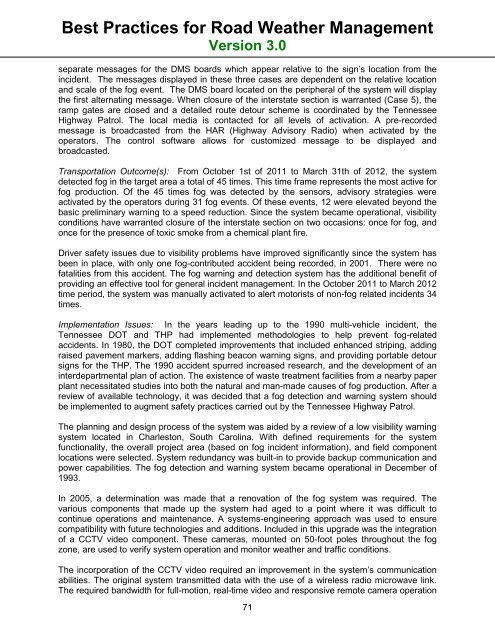Road Weather Management Program - FHWA Operations - U.S. ...
Road Weather Management Program - FHWA Operations - U.S. ...
Road Weather Management Program - FHWA Operations - U.S. ...
You also want an ePaper? Increase the reach of your titles
YUMPU automatically turns print PDFs into web optimized ePapers that Google loves.
Best Practices for <strong>Road</strong> <strong>Weather</strong> <strong>Management</strong>Version 3.0separate messages for the DMS boards which appear relative to the sign’s location from theincident. The messages displayed in these three cases are dependent on the relative locationand scale of the fog event. The DMS board located on the peripheral of the system will displaythe first alternating message. When closure of the interstate section is warranted (Case 5), theramp gates are closed and a detailed route detour scheme is coordinated by the TennesseeHighway Patrol. The local media is contacted for all levels of activation. A pre-recordedmessage is broadcasted from the HAR (Highway Advisory Radio) when activated by theoperators. The control software allows for customized message to be displayed andbroadcasted.Transportation Outcome(s): From October 1st of 2011 to March 31th of 2012, the systemdetected fog in the target area a total of 45 times. This time frame represents the most active forfog production. Of the 45 times fog was detected by the sensors, advisory strategies wereactivated by the operators during 31 fog events. Of these events, 12 were elevated beyond thebasic preliminary warning to a speed reduction. Since the system became operational, visibilityconditions have warranted closure of the interstate section on two occasions: once for fog, andonce for the presence of toxic smoke from a chemical plant fire.Driver safety issues due to visibility problems have improved significantly since the system hasbeen in place, with only one fog-contributed accident being recorded, in 2001. There were nofatalities from this accident. The fog warning and detection system has the additional benefit ofproviding an effective tool for general incident management. In the October 2011 to March 2012time period, the system was manually activated to alert motorists of non-fog related incidents 34times.Implementation Issues: In the years leading up to the 1990 multi-vehicle incident, theTennessee DOT and THP had implemented methodologies to help prevent fog-relatedaccidents. In 1980, the DOT completed improvements that included enhanced striping, addingraised pavement markers, adding flashing beacon warning signs, and providing portable detoursigns for the THP. The 1990 accident spurred increased research, and the development of aninterdepartmental plan of action. The existence of waste treatment facilities from a nearby paperplant necessitated studies into both the natural and man-made causes of fog production. After areview of available technology, it was decided that a fog detection and warning system shouldbe implemented to augment safety practices carried out by the Tennessee Highway Patrol.The planning and design process of the system was aided by a review of a low visibility warningsystem located in Charleston, South Carolina. With defined requirements for the systemfunctionality, the overall project area (based on fog incident information), and field componentlocations were selected. System redundancy was built-in to provide backup communication andpower capabilities. The fog detection and warning system became operational in December of1993.In 2005, a determination was made that a renovation of the fog system was required. Thevarious components that made up the system had aged to a point where it was difficult tocontinue operations and maintenance. A systems-engineering approach was used to ensurecompatibility with future technologies and additions. Included in this upgrade was the integrationof a CCTV video component. These cameras, mounted on 50-foot poles throughout the fogzone, are used to verify system operation and monitor weather and traffic conditions.The incorporation of the CCTV video required an improvement in the system’s communicationabilities. The original system transmitted data with the use of a wireless radio microwave link.The required bandwidth for full-motion, real-time video and responsive remote camera operation71
















